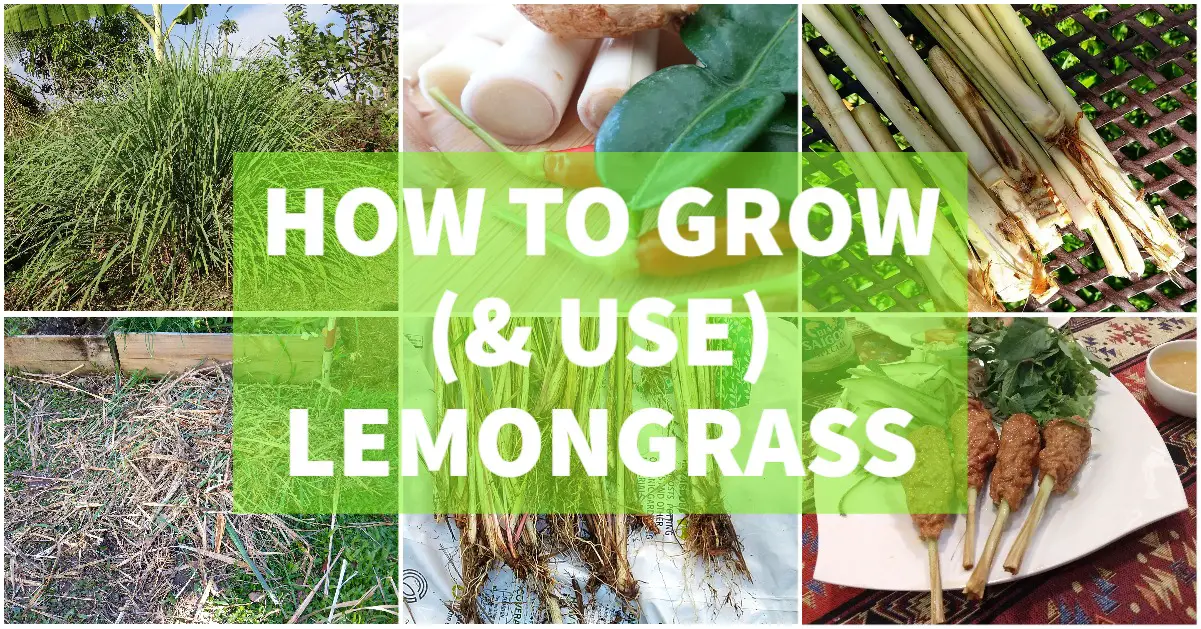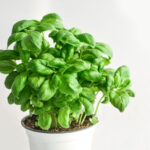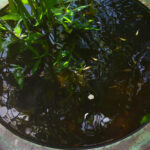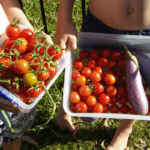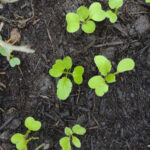This post may contain affiliate links.
How to grow lemongrass? Lemongrass is very easy to grow outdoors if you have the right growing conditions. You can grow lemongrass (Cymbopogon citratus or Cymbopogon flexuosus) in a large pot, raised bed, or direct in your garden soil. Growing lemongrass is easy if you have a tropical climate. In cooler climates, you will likely have to overwinter your lemongrass plant indoors. Lemongrass is a fragrant large grass used in many Asian dishes, teas, and to repel mosquitos. Find out more about growing and propagating lemongrass here!

Grow Lemongrass
Lemongrass is a grass, a perennial herb in the tropics, an easy plant to grow, and is very useful in a range of ways. Discover more on how and why to grow lemongrass here.
How Big Will a Lemongrass Plant Grow?

Lemongrass plants become huge if they are given suitable conditions. The plant can easily reach 6 feet tall and the same diameter.
Lemongrass is a clumping plant, so digging it up to harvest, and dividing the roots will give you multiple smaller plants. If you grow lemongrass in a pot it will stay smaller.
In the tropics lemongrass is a perennial, it grows year-round.
Think carefully about where to position your lemongrass, keeping in mind how huge it will get and the process of lifting and dividing the plant to harvest the lemongrass stalks.
2 Types of Lemongrass
There are two main types of lemongrass Cymbopogon flexuosus (East-Indian lemongrass or Cochin or Malabar grass) native to India, Sri Lanka, Myanmar (Burma), Cambodia, Vietnam and Thailand, and Cymbopogon citratus, West-Indian lemongrass of southeast Asian Malaysian origin. The latter is more typically used for cooking but they all have the lemon like scent and flavour.
Citronella grass (Cymbopogon nardus and Cymbopogon winterianus) are used to make citronella oil
Where To Grow Lemongrass?
Lemongrass plants enjoy full sun, this is one plant you don’t need to shade. Lemongrass likes rich soil with plenty of nutrients. The soil should hold water and remain moist, not become waterlogged.
In the wet tropics, growing lemongrass in a raised mound or bed allows for better draining. We have grown lemongrass for years, with great success in the wet tropics of Australia.
It will grow in the US too, as a perennial in about zone 9 and above. In cooler climates it needs to be overwintered.
Lemongrass really is one of the most hardy and easy-to-grow food plants of the tropics.

How to Propagate Lemongrass
It’s best to propagate lemongrass by division of the clump, but you may also be able to grow lemongrass from store or supermarket bought fresh lemongrass stalks.
If you have a good farmers’ market or Asian grocery store nearby that stocks fresh lemongrass stalks, it’s worth trying to root these in water. Look for the most intact stalks you can find, with some root left on the bottom.
This makes lemongrass yet another food plant you can grow from store-bought scraps.
If you have a gardener friend with a good clump of lemongrass, ask them if they will divide their clump for you and give you some rooted stalks.
Otherwise, it’s best to buy a young lemongrass plant from your nursery or garden centre. Only buy one, this plant will keep you in lemongrass for years!
Lemongrass isn’t very ornamental, it’s a large clump of thick, tall grass with a light green/ bluish shade. We find it makes quite a good edging plant where the edge of a bed receives full sun.
It’s a nice plant to brush against as you walk your garden paths, releasing its scent and deterring those mosquitoes. But beware, those tough fronds can cut and scratch
As lemongrass is a flavouring plant, you could call it a tropical herb, but be careful of growing lemongrass in your herb garden as it could easily overshadow low-growing herbs.
Growing Lemongrass From Supermarket Bought

Yes, you can grow lemongrass from store bought, but if you have a farmers’ market or Asian market, you may have better luck buying it there that in your big supermarket. Supermarket lemongrass stalks may be chemically treated, irradiated, or shipped around the world, but still, it’s worth a try.
Choose lemongrass stalks with some visible roots at the base, if possible.
Just stand the lemongrass stalk in some shallow water, or pot in into rich, moist soil. Retaining moisture is key. It may help to put a plastic bag over the pot to trap moisture and act as a mini greenhouse. You’ll need warm temperatures, in the 20s C at least for it to thrive.
Don’t bury the lemongrass stalk too deep, and don’t stand it in deep water, as it may rot. You may need a small stake to hold it upright. You should see root or green stalk growth within a few days.
We have a full post on food plants you can grow from store bought supplies here.
Does Lemongrass Flower?

Yes, lemongrass flowers in the same way that other grasses do.
Lemongrass flowers in early winter for us in the southern hemisphere tropics, late May to early June. The lemongrass flowers at the same time as most other grasses and the sugar cane.
Will lemongrass self seed? It may, we have multiple lemongrass plants flowering and the tassel-like flowers are wind-pollinated, so we’ll find out soon!
Yes, lemongrass does bloom. Lemongrass is a tropical grass with a lovely lemon scent much valued in cooking. It blooms in the tropical autumn and winter in the southern hemisphere (June – August) in the northern hemisphere lemongrass blooms in late summer, at the same time as many other grasses. Outside of its native climate lemongrass may not bloom at all.
Harvest Lemongrass Without Killing It
To harvest lemongrass you need to divide your clump. You can keep cuttng the tops off for Vietnamese lemongrass tea and they will grow back, but the lemongrass stalks for cooking are the roots of each blade.
So unfortunately you need to dig them up.
There’s no need to dig up the entire clump, just take a part of the growing lemongrass clump.
You can carefully lift the whole lemongrass plant with a garden fork, divide it and replant, or separate a clump by slicing a portion off with a sharp spade and harvesting that part.
Just use a sharp downward motion around the edge of the clump to separate some of the outer blades for eating.
It will help if you cut the green tops off first in the area you plan to harvest.
When should you harvest lemongrass? I harvest it whenever I need it or whenever I need to reduce the size of the clump. That harvest can be at any time of year. In cooler climates you’ll most likely harvest it at the end of summer, at the end of its active growth period.
Overwintering Lemongrass Indoors
If you’re not blessed with a tropical climate, (or zone 9 and over in the US) you may have to overwinter your lemongrass indoors or in an outbuilding if it’s in a pot.
Large clumps can be overwintered outdoors in soil so long as you won’t experience a big freeze. For both, you cut it back hard first. For outdoor, give it a good mulch and try to protect it (maybe fleece) as you would a banana outside in winter. If temperatures dip to below 4C (fridge temperature) you may find your lemongrass will die.
To overwinter lemongrass inside in pots, simply cut your lemongrass back to a couple of inches long and keep it in a cool, dark, environment. This can be a good time to divide your clumps.
It won’t grow in cool conditions (under 60F – 10-15C) or it will stay dormant until conditions are warm enough for growth to begin again. ( It grows best at 75 to 86F or 26 to 30C )
Barely water your lemongrass through winter.
What Can You Do with Lemongrass?
Lemongrass is used as a flavouring ingredient in many Asian dishes, particularly in Thai and Vietnamese food. The Thai noodle soup, Khao Soi used a huge amount of lemongrass and is a good way to use it up. It’s a great way to flavour other tropical vegetable based dishes if you want to try making something new.
In cooking, strip off the hard outer green leaves and use the softer core at the base of each stick. This can be pure white or sometimes a little purple. It’s common to not eat the lemongrass itself, it is present in the soup or curry for flavouring, but stays in your bowl at the end of the meal.
Lemongrass strands are also used as a “stick” to mould meat mixtures around for the grill. You will see this in Vietnam.
Lemongrass tea is usually made with green leaves from the lemongrass plant. In a cool climate, you can dry these for winter use, in a tropical climate you should have leaves fresh in your garden year-round..
Lemongrass is also a popular fragrance used in soaps, deodorants, candles, and of course, citronella mosquito repellent.
Lemongrass Recipes
Lemongrass has a surprising range of culinary uses, from teas and syrups to curries, dips, soups and spring rolls. We have a good selection of lemongrass recipes, from various global cuisines, in this post containing diverse lemongrass recipes.
Other Names For Lemongrass
Lemongrass is sometimes called lemon grass, or any of the following names.
It can be called citronella, British Indian lemongrass, Malabar, Kochi or Cochin lemongrass, Cymbopogon flexuosus, Indian lemongrass, fever grass, sereh, Guatemala lemongrass, Madagascar lemongrass, Melissa grass,, and West Indian lemongrass.
Sereh powder is dried, powdered lemongrass to be used as a flavouring in cooking. You could easily make this at home if you have a dehydrator.
Its Latin name for East Indian lemongrass is Cymbopogon flexuosus, the name for West Indian lemongrass is Cymbopogon ci
How To Grow Thicker Lemongrass
Lemongrass becomes thicker with age, new shoots around the outside of the plant will likely be thin, those in the middle, thicker.
As lemongrass grows better with plenty of nutrients, adequate water, and good sunshine, a lack of any of these things may cause the stems to be thin. Thick lemongrass is the result of plenty of food, sun, and water.
Cutting lemongrass back (harvesting the leafy blades for tea, or cutting back to manage the size of the plant) is also thought to promote thicker stems of lemongrass.
If you cut your lemongrass back hard in the spring, it should grow back abundantly as temperatures rise.
Yes, lemongrass is a perennial grass plant which will grow into a large clump over many years in a hot tropical climate. Lemongrass produces seeds but does not die back after flowering and producing seeds.
Yes, lemongrass enjoys full sun and will grow in full sun even in a hot tropical climate. Lemongrass will grow in shade in hot climates, but its growth will be stunted by the lack of light.
Have Fun Growing Lemongrass!
This tough plant is fun to grow and rapidly fills a space. As a culinary ingredient, it is a superstar in Asian cuisine. If you love your Asian flavours, plant lemongrass in your garden along with gingers, chillies and citrus. Consider growing small round Thai aubergines (eggplants) that make your green curry so much more authentic. All of these plants grow great in a tropical climate.
